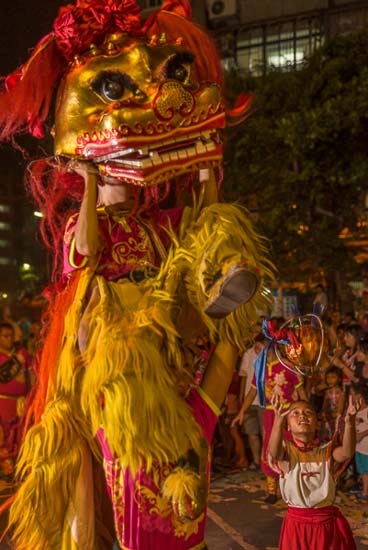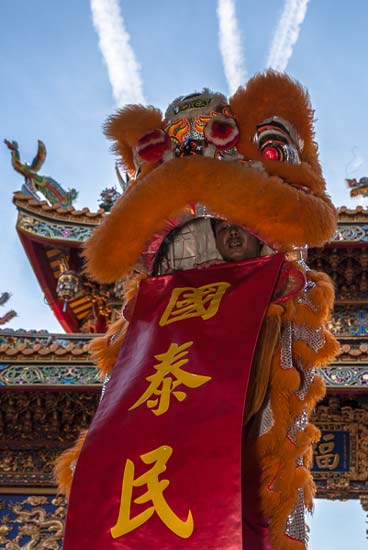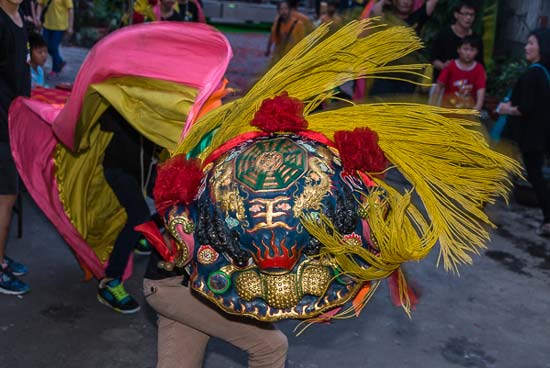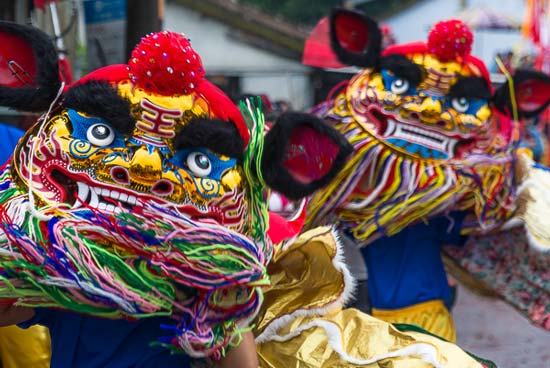Gods of Taiwan
Lion Dance, 金獅獻瑞 (jin shi xian rui)

Northern Lion Dance (北獅)
Animals, both mythical and real, play a major role in the Popular Religion of Taiwan, and the lion is no exception. Not native to mainland China, lions do not feature in the most ancient of its beliefs, unlike the tiger or dragon. However, lions began to be imported both dead and alive, as trade and tribute, during the Han Dynasty in approximately the 3rd Century AD. From this point they were rapidly integrated into the culture and faith, being used as a symbol of power for the Imperial Dynasties, and to ward off evil spirits.

Southern Lion (南獅) with blessing scroll
The origins of the lion dance itself are not precisely known, but may well also have been imported from central Asia, where Asiatic lions were native and widespread. The Persians are known to have performed a lion dance during their new year celebrations, and Persian performers travelled to China during the Tang Dynasty (7th-10th Century AD). There are several alternative stories explaining the presence of lions in Chinese culture, however, which also help to explain the appearance and aspects of the performance of the lion dance still seen today. One of these involves the Jade Emperor 玉皇 (Yu Huang), one of the highest gods of Taoism. In this legend, the lion originally lived in heaven, but due to its aggressive nature, the Jade Emperor had it decapitated. The Buddhist goddess of mercy, Guan Yin (觀音), pitied the lion, and revived it by reconnecting its head using a red thread, and in part because of this myth, the lion and lion dance is often associated with Buddhism. Another myth is that the image of a lion appeared in a dream to an Emperor in the Tang Dynasty, who ordered its likeness to be recreated. A further one from southern China tells of a monster called Nian Shou (年獸), which terrified the people of a village each New Year Eve, until they connected a fabricated head and material to create their own Nian monster, forever scaring away their tormentor.
Several different styles of lion can be seen in Taiwan nowadays, with differing styles of dance, although each lion almost always has two performers inside, one controlling the head and the other the body.
Probably the least common in Taiwan is the northern lion 北獅 (bei shi), with a generally more amiable appearance, long fur, and a graceful, playful dance. They are sometimes accompanied by a performer holding a ball, who performs acrobatics during the dance.
The southern lion 南獅 (nan shi) originates from Guangdong province, and is the form used in Hong Kong, as well as often in Taiwan. The southern lion has a more fearsome appearance, and is associated with height, as the routines often involve the rear performer lifting the front one, and skillful performances atop a series of raised columns.

Taipei Lion (台北獅) Performing
In addition to these two well known forms from China, Taiwan is home to many troupes performing the dance of the northern Taiwanese or Taipei lion 台北獅 (tai bei shi). These lions feature a hard, papier-mache head, with the character 王 (wang) meaning king in the upper middle of the face, connected to material. The dance of the Taipei lion features movements which are more sharp and sudden than other styles, in part because the head of the lion is hinged, allowing the performers to produce sound when the two parts hit each other.
Southern Taiwan features its own distinct southern lion 南部獅 (nan bu shi), smaller than other variants and often performed by children. The Southern Taiwan lion, along with other variants, is sometimes accompanied by a performer in a papier-mache smiling head with the appearance of the big headed buddha 大头佛 (da tou fu). This may relate to a legend of a lion kept by a Tang Dynasty Emperor, who could not be tamed, until a friendly Buddhist monk managed to calm it.
The Hakka lion 客家獅 (ke jia shi) is similar to the southern Taiwan lion, but with an opening, hinged mouth.

Southern Taiwan Lion (南部獅) Performance
Lion performances are accompanied by a loud drum beat 鼓藝震天 (gu yi zhen tian), named because it can shake the sky. This is performed by other members of the troupe, often on large drums, carried on the back of a truck. All troupe members, including the lion dancers, are generally proficient drummers, and a lion dance performance is often followed by a drum performance by the whole troupe.
While the movements of different lion types and even different troupes vary, to a greater of lesser degree, all try to mimic animal movements. To this end, a typical lion dance often involves the lion at times sleeping, licking its fur, playing and eating, amongst others. The eating aspect is particularly meaningful - the lion is often fed some form of leafy vegetable, performing the 'plucking green' 採青 (cai qing), as in Chinese the word for pluck sounds similar that of vegetable, whilst green sounds similar to fortune. Nowadays, the vegetables are often substituted for a number of alternatives, including beer! The lion is often also 'fed' a red envelope, containing money, as payment for the dance. Lion dances normally end with the lions picking up scrolls in their mouths, and unrolling them to reveal a blessing 吉祥對聯 (ji xiang dui lian). They may then sit on the end of a long pole 一柱擎天 (yi zhu qing tian) which is raised by a team of people, so that the lion is several metres from the ground.
Previous: Guan Jiang ShouNext: Dragon Dance
